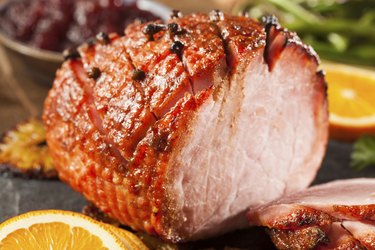
With its concentrated source of nutrients and quality protein, meat provides a high-value food in almost every culture. Unfortunately, it's also a highly perishable food, and consequently the ability to preserve it through curing has been a vital survival skill through the centuries. In the modern world, you can obtain fresh meat from refrigerated showcases year-round, but cured meats remain popular because of their potent flavors. That gives you the flexibility to choose, at a given meal, whichever form is appropriate.
Anatomy of a Cure
Video of the Day
Salt provides the crucial ingredient in cured meats, as it disrupts the cellular activity of bacteria that might otherwise cause spoilage or illness. Sugar can moderate the salt's harshness and act as preservative in its own right. Cured meats are often smoked as well, which does little for food safety but helps prevent rancidity. The other crucial ingredient in most cured meats is nitrates or nitrites in some form. These give cured meats their delicately rosy color and provide them with their signature flavors. On a more practical note, they also kill Clostridium botulinum, the bacteria responsible for botulism.
Video of the Day
Cured vs. Uncured
Cured meats can easily be distinguished from uncured meats by their texture, color and aroma. The salting process leaves the muscle fibers slightly denser than before, as proteins in the meat contract. This is why ham's texture is distinctly different from the texture of a pork roast, even when the two cuts come from the same part of the animal. The distinctive ruddiness of cured meats is also immediately recognizable, differing from the paleness of uncured pork or the deep red of beef. Most important, cured meats possess deep and complex flavors created by beneficial bacteria, yeasts and enzymes during the curing process.
Cured But Not
Oddly, some obviously cured meats such as bacon, ham and deli sausages are sold as "uncured" in retail stores. This is a regulatory and marketing quirk, growing from consumer demand. Some health-conscious diners wish to avoid nitrates and nitrites, either because of their weak association with cancer or from a simple desire to minimize their consumption of chemicals in general. Most such foods are cured instead with celery juice or powder, because celery is a potent source of natural nitrates. These nitrates naturally turn into nitrites during the curing process, but the nitrites haven't been "added" by the processor. Because of this, such meats must be labeled as "uncured" under U.S. law.
On the Table
Even in small quantities, cured meats instill their character into every dish. That's a boon to frugal or budget-challenged cooks, who can flavor an entire pot of inexpensive beans or vegetables with a ham bone or a few morsels of bacon. Yet that flavor also imposes limits, and a pork chop or a piece of fresh beef is infinitely more versatile than its cured equivalent. Ultimately, the choice comes down to your desired result. For example, a pork hock and a smoked hock will each enrich a pot of greens, but the smoked hock imposes its own flavor while the fresh hock leaves center stage to the taste of the greens.